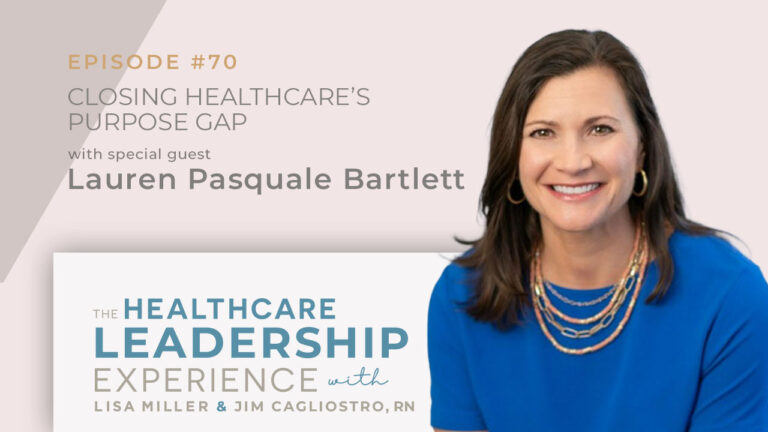We’re taking a deep dive into what zero-based budgeting will do for your hospital.
In Episode 41 of The Healthcare Leadership Experience, Lisa is joined by her show producer Lisa Larter. Together they discuss zero-based budgeting for hospitals.
As Lisa Miller comments, ‘’Sometimes it’s not about pricing. Sometimes it’s not about consolidation. Sometimes it’s going through your hospital’s budget…department by department. Test it out, ask some questions. It’s definitely a different approach from traditional budgeting. It’s very precise.’’
This episode is sponsored by VIE Healthcare Consulting® which has proudly helped hospitals save $772 million since 1999.
In This Episode You’ll Hear:
- Starting from the ground floor; why making the mindset shift to zero-based budgeting can lead to substantial cost savings for your hospital.
- Taking a deep dive into your service levels: If your minimum service level is 15 per month, how many of those services is your hospital really using?
- Combining zero-based budgeting with additional strategies and a recommendation from Lisa Larter,‘’If I increased my prices and/or sales by 10% and reduce my total costs by 5% I would net out at more than double my profitability in the previous year.’’
- How adopting a cost analysis by category or department can help to identify hidden overlooked cost savings opportunities.
- The pros and cons of zero-based budgeting, and why subscription services costs offer a good starting point.
- How reviewing every new maintenance contract for one hospital resulted in multi-million dollar savings for one hospital. ‘’No-one wants another committee, but if you have other people asking ‘’why are we doing it this way?’’ you get different thinking and answers to questions.’’
- The need to recognize ‘’decision fatigue’’ and a powerful example of how to avoid it.
What To Do Next:
- Subscribe to The Cost Advantage for Healthcare Leaders and receive a special report on 15 Effective Cost Savings Strategies
- Learn more about the simple 3 step process to work with us.
- If you are interested in learning more, the quickest way to get your questions answered is to speak with one of our margin improvement experts. Schedule a call with our team.
Connect with Lisa:
📱 https://www.linkedin.com/in/lisamiller/
Episode Transcripts
CLICK HERE TO DOWNLOAD THE PDF TRANSCRIPT
CLICK HERE TO OPEN THE TRANSCRIPT
Introduction (00:02):
Welcome to The Healthcare Leadership Experience Radio Show with your host, Lisa Miller. Lisa is an entrepreneur, inventor, advisor, and founder of VIE Healthcare Consulting, the leading healthcare advisory and analytics firm, helping hospitals accelerate their margin improvement goals.
Lisa loves to think differently and collaborates with leaders and their teams to solve challenges and to create new innovative approaches that impact the clinical and business side of healthcare.
Our show will bring you leaders and innovators within healthcare and across multiple industries. Be a part of the discussion that will give you a unique perspective, deep insights, and roadmaps to successfully help you navigate the clinical, financial, and operations of healthcare. Your show starts now.
Lisa Miller (00:49):
Hello, you’re listening to The Healthcare Leadership Experience Radio Show on HealthcareNOW Radio. I’m your host Lisa Miller. I am excited today because we have back to the show, Lisa Larter, our producer. Welcome, Lisa.
Lisa Larter (01:04):
Thank you. It’s great to be here with you.
Lisa Miller (01:07):
Yeah. I’m excited that we have a couple of episodes together and some of our best feedback and shows have been with you. And so this will be fun. So welcome back.
Lisa Larter (01:17):
Thank you. I love the topics that you have planned for today’s show and next week’s as well.
Lisa Miller (01:22):
Yeah, there are kind of two different topics on the spectrum. One is gonna be finance and one is gonna be really on healthcare disruption next week. So, today, we are talking about zero-based budgeting. So this is primarily a finance conversation. However, I do feel like it’s an operational discussion. And we’re s- explain today what it is. I have some questions that I ask my clients as we’re starting this journey of zero-based budgeting.
And then if you wait to the end, I’m gonna give you a specific example of the way we work with a client and how we go through the process and, and a success story. So, now, if you were to Google zero-based budgeting on the internet, you’re gonna get a lot of information, and it’s widely used in corporations. It is not an unfamiliar topic. It’s probably an approach strategy, that’s not really used much in healthcare.
And, you know, I’m not really sure why that is, but, you know, it’s a conversation that I have more and more with my clients and in hospitals as we are beginning our cost-reduction initiatives. And so we’re getting more interest. And it’s interesting that the CFOs are like, oh, I would love to do zero-based budgeting, Lisa. It’s such a discipline and thoughtful way. It’s financial stewardship. It’s, it’s such an approach we’d love to do.
So I’m gonna give a basic definition for those. So it’s a budgeting approach. And it really involves creating a brand-new budget from scratch. So usually, what happens is you have a budget from last year and you say, oh, I’m gonna take out 5% or maybe I’ll go through some of my most expensive areas. And maybe I’ll take out 7% there, or 5% overall.
But zero-based budgeting assumes you have zero budget and you’ve gotta justify every single cost and expense. And, you know, usually it’s done for a period, like a year. Some people do it every two or three years. In, in corporations in the Fortune 500, they have a different cycles. So it could be two years, three years, or a year. But every function within the organization, from an expense perspective, is analyzed for its needs and costs.
And then they build that budget around it. So again, outside of healthcare, you could have a manufacturing organization that’s looking at even costs to build, you know, a microphone. or, and looking at even that as a zero-based budgeting approach, right? Even, um, matching up what it costs for that output of a product, right? And then they examine, you know, different aspects.
Lisa Larter (03:57):
So, zero-based budgeting means that you start from the ground floor. You don’t look at what you’ve spent before. You kind of like just throw it all out the window and look at what you need to spend? Like, I guess my question for you is how do you transition from doing what you’ve done to this zero-based budgeting approach? Because I felt like you were maybe so spying on my computer when you said most companies wanna take 5% out, ’cause that’s one of my goals this year, (laughs) is how do I reduce cost by 5%? So how do you shift to this way of thinking?
Lisa Miller (04:30):
Yeah. That’s a great question. And I actually think that this is a bigger mindset and thinking approach or issue than, you know, the time it may take or, oh, I’ve never done this before, or it doesn’t even seem rational. This seems irrational almost.
I can give you an example. Maybe I’ll give you an example as it relates to, you know, a hospital. So you could have a, a department in a hospital and you have to assume there’s no budget. And we’ll, maybe we’ll take the lab for instance. And now you’ve got to build out what it’s going to cost for that lab. So the lab may have 15 pieces of equipment, maybe 40 service and maintenance contracts, maybe there’s outsourced services. I mean, this is non-labour. So we’re gonna take the labor out for a minute, but examining every single cost to say, do I need this or not?
So that lab may decide, well, listen, I have a piece of equipment, I have a backup piece of equipment, and I have a third backup. We don’t use, I like it because it’s there, but maybe I don’t need that. Or if I have it and I’ve already paid for it, do I need a service and maintenance contract on it?
So we see that a lot. We see three pieces of equipment. Maybe there’s a redundancy, it makes sense, but does that third piece of equipment need a full-service and maintenance contract? Maybe it just needs parts and labor. So as we build out the department, as you’re analyzing every single expense, there may be an opportunity to say, listen, we’re outsourcing this test and I didn’t realize we spent a million dollars a year outsourcing. Maybe it makes sense for us to justify bringing that in. And bringing it in is half the cost.
You know, we have some clients that, again, they go, they have outsourced services and they minimum fees. It’s minimum fee usage of 15 or 20 per service in order to have a piece of equipment or have the service. And then as you’re analyzing the expenses, you’re like, wait a minute. We’re only using that 4 or 5 times, yet our minimum usage fee is 15 or 20. And so you’re really paying 5 or 6X more.
So this whole discipline around, do I need it? Should I be paying for it the way I should be paying for it? There’s another way to think about it. Even, you know, we’ll see food and supply costs to the departments. And departments can order like apple juice and crackers for the, you know, for the floors. And the departments that they’re attached to their P&L, you can see that they are really kind of watching that supply. You know, that food supply. You know, it’s, it’s the extra crackers, the extra juices, all those extra. Versus the ones who don’t have it attached their P&L, the hospital can look by department and you can see it’s just a big expense.
So when they get that visibility, do I need it or not? Is there another way to look at it? It’s a different approach.
Lisa Larter (07:25):
Yeah. So it sounds to me like it’s more of a thoughtful line-item analysis that allows you to really truly assess how much money you need to spend or budget for based on what makes sense, versus looking at the total roll-up of a spend and saying, where can we cut 5%?
Lisa Miller (07:45):
Yeah. Absolutely. And I often will say, more than likely. just cutting that 5%. You’re probably undervaluing the opportunity. So let’s talk through your opportunity right now, right? So you’re gonna take 5% out, which is great. I mean, that’s so smart for you to look at it in that respect. And I could take it from my perspective, too. Right? So as an owner of business, I wanna take out similarly, 5%, 7%, but if we really question, do I need that subscription? Do I need the extra layer of subscription?
You know, Keith Cunningham says, we pimp out some of our buys, you know, do you need the iMac Pro Pro Pro? Or we just, you know, last year’s model work. And I think that’s the thoughtfulness, right? It’s, do we buy more? Do we buy the most expensive? We’re not getting the extra. Does the extra bring us more profit? And that’s the same for a department.
Lisa Larter (08:39):
Yeah. Absolutely. Absolutely. It’s really interesting, you know, I did this analysis on my business that if I increased my prices or I increased my revenues by 10% and I reduce my cost by 5%, I would more than double my profit from last year.
Lisa Miller (08:56):
Right. You can say that one more time, because I think that hospitals need to hear this, ’cause it’s a combination of things.
Lisa Larter (09:04):
Right. So I did an analysis on, if I increased my prices and/or increased my sales by 10%, and I reduced my total cost by 5%, I would net out at more than double my profitability from the previous year.
Lisa Miller (09:26):
So that formula could be used the same as, uh, and within hospitals, right? Hospitals can increase their prices, but they could increase their collections and they can optimize by 10%. And then reduce their costs by 5%. And then they double the profitability. That is the most brilliant model that everybody listening should be thinking about.
Lisa Larter (09:47):
Yeah. And I even looked at reducing my cost by 5% without reducing my labor cost.
Lisa Miller (09:54):
Oh, yeah. There you go.
Lisa Larter (09:55):
Because people think automatically that’s the biggest line item, let me reduce my labor. But you can’t. And, you know, and I can’t. And most hospitals, they can maybe optimize different aspects, but we’re not looking to reduce labor costs. No way.
Lisa Miller (10:08):
Mm-hmm (affirmative). Yeah. I love this. This is really, really interesting.
Lisa Larter (10:12):
And, you know, costs sometimes isn’t the glamorous topic. I often say people love conversations about improving revenue or, or having growth or innovation, and, but optimization and looking at cost is like it’s the secondary or third, uh, review. And not everyone gets excited about it, but it, it has such a meaningful impact on profitability.
And so sometimes it’s not about pricing. Sometimes it’s not about consolidation. Sometimes it’s just really going through your hospital’s budget, go through by department by department. Test it out, or in a category and just ask some questions. And we’re gonna talk about some, but it’s definitely a different approach from traditional budgeting. It’s a very precise. It’s thoughtful.
And for me, again, I’m gonna go back to being a small business owner. I still have a lot of costs, and, and they get hidden in so many different areas. And if you really have to sit down and really be focused, you could take out 5%, and I’m sure. I could as well. It’s just putting yourself seated, focused, and dedicating the time and really asking the tough questions. And if you can’t figure out like, oh, I need that, or do I really need that? (laughs). Like sit down and do pros and cons, or how else can I look at this cost? Is there a hybrid approach?
But I don’t think, unless you do the thinking, you’re are gonna get to those really deep, deep cost savings.
Lisa Larter (11:40)
Absolutely.
Lisa Miller (11:42):
So, Lisa, I get asked often, what are some of those other advantages and maybe some of the disadvantages? Right? So some of the advantages are obvious. They are, you know, you really get to look at your operations, you get to you lower your cost, you have some insights that you didn’t have before. And you have some, some strategic areas to focus on. I mean, it does give you some unique perspective.
Now, there are some disadvantages. And it definitely is, it’s timely and it’s resource-intensive. So that’s the case. And, you know, that’s why we help a lot of our hospitals with kind of gathering the data and putting a framework together and throwing out those costs in those areas and make it simple and easier for them. But it will take time. I, I think the time is well spent. And, you know, we really try to help our clients with a turnkey approach. But I think that’s what just detracts everybody.
And I think the other one that detracts everyone, frankly, is I got this covered. I know what’s going on in my department. There’s nothing that needs to be reviewed. And I think it’s mindset, right? Everyone kind of feels like I got this covered. (laughs) And to do this exercise almost seems like you’re telling me I don’t know what going on. I think that, you know, they just don’t believe that this kind of approach is going to reap those rewards.
Lisa Larter (12:59):
Yeah, for sure. And I think you don’t know what you don’t know until you know. And when you look at those line-item details and really get clear on your budgeting, there’s just so many things. I mean, as a small business owner, there’s so many things I find, I can’t imagine what it must be like for, you know, the CEO or the CFO of a hospital.
Lisa Miller (13:20):
Yeah. So I’m gonna give one example and then we’re gonna kind of go through a process shortly. So for my, so for myself and our hospital clients, these subscription services are a big area to review. And not all subscription services are bad, however, most subscription services are underutilized, or not utilized, or they have these different tiers. And just by pulling out all your subscription services, just start there. What’s recurring? And a lot of them are hidden sometimes within maybe a medical manufacturer or service provider or GPO.
So you have to dig. But it’s a big opportunity. And looking at your subscription services and saying, okay, what am I getting? Are there different tier? Or, I bought this subscription services 10 years ago, 5 years ago, 2 years ago. There’s a different pricing model in place. I found things, you know, that I have for our company and then I go and find out that I’m on a legacy or an older subscription plan. There’s a better subscription plan now.
I think that’s just, you know, one kind of view for a hospital to, to really understand, just go into your annual subscription services, but you gotta find them.
Lisa Larter (14:34):
You gotta find them. And you have to look at them on a month-over-month basis too, if you’re paying monthly. I recently had a subscription service that jumped by 50% from one month to the next because a member of my team was adding additional users and didn’t realize that adding the additional users was actually going to cost us more money. And I didn’t get any notification. They just started billing me more.
Lisa Miller (14:58):
Now imagine that with a hospital that has 5,000, 10,000, 20,000 employees. And just that one area. That’s why I say it may not be a department, it could be a category, or it could be subscription services. I can’t tell you how many times hospitals go through their GPO agreements and they’re subscribed to 6, 7, 8, 9, 10 data analytics services and half of them nobody’s using.
And it’s almost like a security blanket. They’re like, wait, but what if one day we need ’em? You know? And it’s like, okay, well then sign up for them, (laughs) or look at it differently. So if you’re just turning in, you are listening to the Healthcare Leadership Experience Radio Show on HealthcareNOW Radio. And I’m your host, Lisa Miller.
Today I’m joined with our producer, Lisa Larter. And this show is sponsored by VIE Healthcare Consulting, the leading healthcare advisory and analytics firm, helping hospitals accelerate their cost savings and margin improvement goals, since 1999. You can learn more about VIE Healthcare at viehealthcare.com.
So, Lisa, I have a story and then some questions and like a methodology framework for everyone. So, years ago, how this all began, that is about 12 years ago. We had a client we had worked with for several years. And they wanted to keep on taking a deeper and deeper view. And, you know, that’s when I learned about zero-based budgeting. I believe the inventor came out of Texas Instruments. I think Peter Pyhrr is his name and he’s really known for this approach.
So I started looking into it and I spoke to the COO and he was familiar with zero-based budgeting. And we tackled the category of spend. It was all their support, contracts, service, and maintenance contracts. And he said he wanted every single service or support or maintenance contract to be reviewed no matter where it was in the hospital.
And we had a committee. And that committee was four or five people. We were on the committee. And any new contract and that category had to be reviewed. So instead of us going out and having that zero-based approach on the front end, we said, okay, let’s, this is hard, let’s tackle it so when something new comes in, it can’t be renewed or paid for. Right?
So every single agreement that was either renewed eve- throughout the whole hospital had to come through the committee. And two things happened. One is we pulled out 37% of those costs either in support, service, or maintenance. 37%. It was huge. It was a multimillion dollar savings beyond what we had done in contracting, pricing, utilization. It was just vetting this whole process. And nothing could be paid. So we had stops in AP. We had this group. And we met every week to talk about these three types of agreements and we had a framework.
And then the second thing that came out of it was there was a support agreement for an energy project that, that COO who was running this in initiative had approved. Right? So it’s from the COO, it was significant. It was a few hundred thousand dollars. And everybody was nervous like, we can’t have this come through. (laughs) Like, we just have to approve it. And I said, no, he’s gonna want us to have this discipline.
So we reviewed it. And funny, we found out that this renewal for this energy project was covered already by another service the hospital was providing. So everyone was-
Lisa Larter (18:39):
Go away.
Lisa Miller (18:39):
Yeah. Totally covered. A 100%. And so we went back to ’em and we said, listen, it’s not that we don’t think this is valuable, that you don’t need it, but it’s covered. I’m not sure that you knew this whole support was covered from another area, another service. And he was like, that’s fantastic. You know, it was a few hundred thousand dollars we had saved.
And you know, it was a lesson for all of us, because if you would think about it, was the COO and, you know, no one wants to say no. In fact, everybody was like, no, no, no, it’s okay. This has been vetted. This is what he wants. No one’s gonna question it. And I was like, no, we still need to go through the process even if it comes out the same. But if anything, he will be happy that we had this rigor and we still had the same process. And lo and behold, it was a cost that it went away entirely. It’s like one of my favorite stories.
Lisa Larter (19:29):
That’s amazing. I love the committee idea to vet expenses and what a great example of leadership to actually put the ball into somebody else’s court and have them objectively review and make decisions around whether or not this expense should continue or not. It’s really smart.
Lisa Miller (19:49):
Yeah. So it’s funny because I think that’s the best way to do this. And, you know, and no one wants another committee or another group, but we kept it small. And we kept it very fast moving. We kept it weekly. We had an agenda. We had everything on what we needed to speak about. And they enjoyed it, because we got to ask really innovative questions and thinking questions, right?
And you’re right. When you have other people outside the group, having a committee about these agreements, I think you’re like, well, yeah, why are we doing it this way? You, you get different thinking, different answers to questions. So I agree. I think that’s a great approach.
Lisa Larter (20:28):
Mm-hmm (affirmative). Absolutely.
Lisa Miller (20:29):
You know, it’s leadership too, the COO was open to having this process and supporting it. And, you know, that’s really important, because a lot of times some of these committees fall off, for people fall off, but if you can make this committee for like 6 months, you get lots of wins and incentivize the hospital or different ways to incentivize people and, or even just showing what’s going on. It’s just the excitement. You know, people will get on board.
Lisa Larter (20:57):
One thing you said though, that I think is really, really powerful, and you just kind of said it like it was no big deal is to justify the spend when it comes through. So you guys actually created a process so that people didn’t have to get overwhelmed by looking at every single agreement at once. It was timed so that you could look at them as they came due and you could make those decisions.
And, you know, from what I’ve read about decision fatigue, if you are actually having to look at hundreds of agreements, all in one setting, your energy for looking at things objectively is going to wane by the end of the day. So even that one strategy of just reviewing every single month of the year over a 12-month period is so powerful.
Lisa Miller (21:47):
That’s a good point, because people do get decision fatigue. And even like in a day, you know, you and I both read that book, you know, in the morning you have this full capacity of a full tank of gas. It’s for even to make decisions. And by the end of the day, depending on stress or how we eat or movement, we end up making poor decisions. You’re right. So if you have like a hundred contracts you’re reviewing, your ability to make good decisions is probably not gonna be so great at the end of the day.
Lisa Larter (22:13):
Right. And/or if you have like five in a row that you think are nos and the sixth one feels like a no, you might rationalize, well, we just said no to the last five-
Lisa Miller (22:22):
Yeah.
Lisa Larter (22:22):
… because they’re all so close together.
Lisa Miller (22:23):
Yeah.
Lisa Larter (22:23):
So I think that’s a really smart way of looking at it.
Lisa Miller (22:27):
We felt like better in tackling it all on the front end, we would tackle it as they came in. And it was very successful. So, you know, these are some of the questions that we like to ask, do we need this expense? Okay. It seems very generic or very easy question, but it’s a really important question to ask, right? Do we need this expense? Are we using it? Are we using it to the capacity that we should be using it? There’s a different way to approach this expense. Maybe we could outsource it, maybe insource it. Consolidation’s always an option.
Sometimes it’s going back to this provider to say, is there anything new you’re doing here? As we look to the future, we’re gonna be spending more money, can you absorb this, this new SAS, this new service for a year? And then really understand the total cost of ownership. And the big one that I speak about often, when was the last time we reviewed the invoices extensively? So we’re not getting the reports, when do we actually have paper invoices? Or if you, if you call us up, we’ll help you with our invoice, ROI, and technology. But whenever you reviewed those invoices, because I’ll tell you, that is really one of the principles of zero-based budgeting, is understand those real costs on those invoices.
So those are some of the questions. And I think hopefully we covered a quasi, you know, financial, maybe not as interesting topics, some interest, but with some strategies, right? It’s important. Maybe pick a department. Don’t look at the whole hospital as a zero-based budgeting. Cause it’s too overwhelming. Pick a department. Pick an expense area. Pick a category. Get wins. Be strategic about. But do something. And you’re gonna come up with some opportunities.
Lisa Larter (24:08):
Something I heard someone talk about the other day that was, I thought was really helpful is when they were looking at all of their expenses, they actually highlight them in different colors. So if it’s an expense that is one that they wanna keep and it’s good, they highlighted in green. If it’s one that they need more information on, they highlight it in yellow. And if it’s one that needs to be stopped, they highlighted in red.
And I thought, what a really brilliant way to just print out all of your expenses and look at them at a glance? Now, I get that a hospital isn’t going to be able to print out every single expense, but maybe there’s category that they could be looking at through this lens. And if there’s something on that list that they don’t know what it is, then it really should be a yellow. And that’s where you should be looking at this committee to determine whether or not it is an expense you wanna keep.
Lisa Miller (25:00):
I love that. Such a visual way. But they could take an invoice. And maybe go through the invoices and do their red, yellow, green. But I love that. And some of their accounting systems are a little more sophisticated, but that’s a great idea. Thank you. I love that you shared it. I might have to use that. (laughs)
So, Lisa, thank you for joining me today on The Healthcare Leadership Experience. It was great.
Lisa Larter (25:23):
Yeah. It was great to hear you talk about this. I feel like I, I need to go back and look at all my expenses. (laughs)
Lisa Miller (25:29):
We can help you with that. Thank you, Lisa, for being on the show. And we appreciate all the listenership.
If you’ve got a topic you would like to have us speak about, please reach out to me. I’m on LinkedIn. I’m also in the show notes. You can reach out to me on my email.
Thank you for listening to Healthcare Leadership Experience Radio Show on HealthcareNOW Radio. I’m Lisa Miller, the host. And join us every day at 5:00 AM, 1:00 PM, and 9:00 PM. And we’re on all podcast apps.
We’ll talk soon. Thank you.
Outroduction (26:03):
Thank you for joining Lisa Miller for this episode of the Healthcare Leadership Experience Radio Show, sponsored by VIE Healthcare consulting. If you enjoyed the show subscribe so you can automatically get notified when new shows premier weekly. Don’t forget to leave us a review. Some more healthcare leaders like you can discover us.
This show is on HealthcareNOW Radio, Apple Podcast, Stitcher, Spotify, Pandora, and other major podcast platforms.
To reach out to Lisa personally, you can join the conversation on LinkedIn, where Lisa continues to have discussions on the business of healthcare.
You can find links to Lisa’s other social platforms in the show notes or at viehealthcare.com.
The Healthcare Leadership Experience Radio Show is the think differently communication for healthcare leaders and are honored to have you tune in.
Join us next week for another episode of The Healthcare Leadership Experience Radio Show.











